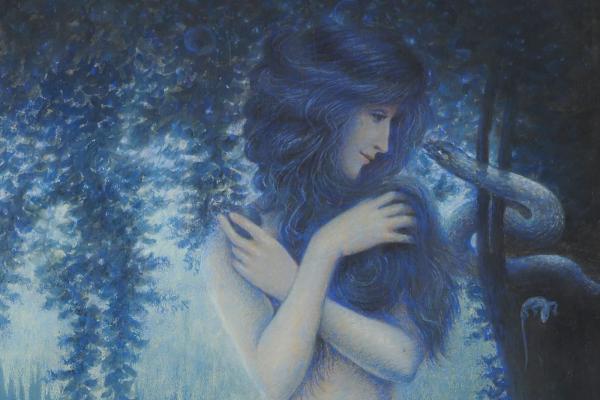Press article : The first woman according to Lévy-Dhurmer - La Gazette Drouot
The first woman according to Lévy-Dhurmer - La Gazette Drouot
- 12/19/24
- Paintings

Eve and the Snake, circa 1897-1899
A multi-talented artist, Lucien Lévy-Dhurmer was a ceramist before becoming a painter and, above all, a pastelist. This is undoubtedly why this pastel in shades of blue, with its biblical subject, has a porcelain effect. He particularly excelled in this medium, his art resting on a great mastery of drawing and purity of line, the enigmatic atmosphere of his compositions benefiting from a skilful play on the velvetiness and mattness of the pastel. Kept until now in a private French collection, this composition has a bewitching and resolutely mystical charm, tinged with a sense of mystery. There are eight other works by Dhurmer on the theme of Eve and the snake, this being the ninth known. The most famous, in gouache and pastel with gold highlights on paper laid down on canvas, shows the young woman in profile in very close-up, in bust form with her hands folded on her chest, looking at the snake. Only the head is visible, as well as part of the sinuous body passing behind the abundant red hair. At the back, the tree of the knowledge of good and evil, with its profuse foliage, appears like a curtain. According to the artist's notes, it belonged to a certain ‘Mme Th. Singer’, and was also part of the collection of antique dealer and collector Michel Périnet (1930-2020 - see Gazette 2020 no. 4, page 12). It is reputed to be the work that brought the artist success, when it was exhibited at the Galerie Georges Petit in early 1896.
Lucien Lévy-Dhurmer (1865-1953) - Eve and the snake, vers 1897-1899
Pastel on paper laid down on cardboard, signed, 97,5 x 43,5 cm (détail).
Estimate : 60000/80000€
Fateful moment
In 1902, the French government even commissioned Dhurmer to design a tapestry on the theme of Eve tempted by the snake for 6000 francs (almost 27000€ in today's money). The huge canvas (318 x 410 cm), entitled "Première floraison", is now in the collections of the CNAP, but the tapestry was never made. The figure of Eve thus occupied the artist for many years. This pastel, one of the earliest existing versions - which will be included in the catalogue raisonné of the artist's work, currently being prepared by Marc-Henri Tellier - shows how Dhurmer envisaged the image of the first biblical woman. Here he depicts her in an unambiguous nudity, her ample brown hair concealing her breasts, at the fateful moment when, still innocent, she allows herself to be seduced by the snake - the fatal fruit is already in her left hand - leading to her fall and that of Adam.
In a fairly tight framing, with a curved top, he places her in the centre of the composition, in an idyllic landscape populated by a few butterflies and dragonflies at her feet, two lizards climbing the trunk where the snake is coiled. Behind her, a peaceful lake fringed by tall trees creates an atmosphere of mystery, reinforced by the work's blue palette, which adds a twilight hue that foreshadows the drama that is about to unfold. We are reminded here of the Renaissance masters, but there is also a Pre-Raphaelite dimension in this pastel, bringing it closer to the art of Edward Burne-Jones. The painter's exhibition in Paris in 1878 had a major impact on the Paris art scene, and Dhurmer was no exception.
LA GAZETTE DROUOT N° 46 OF DECEMBER 20, 2024 p.37 BY CHRISTOPHE PROVOT

